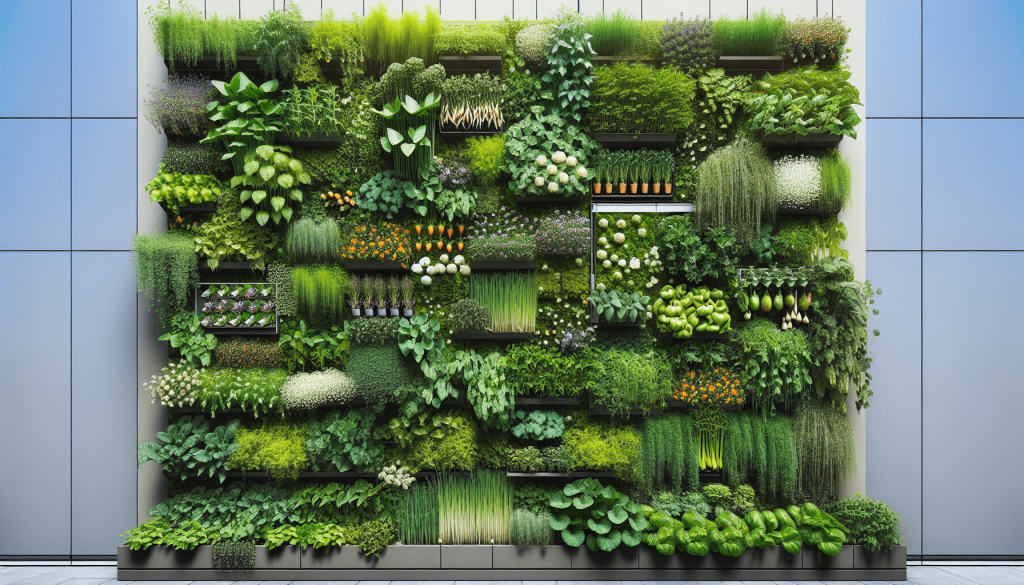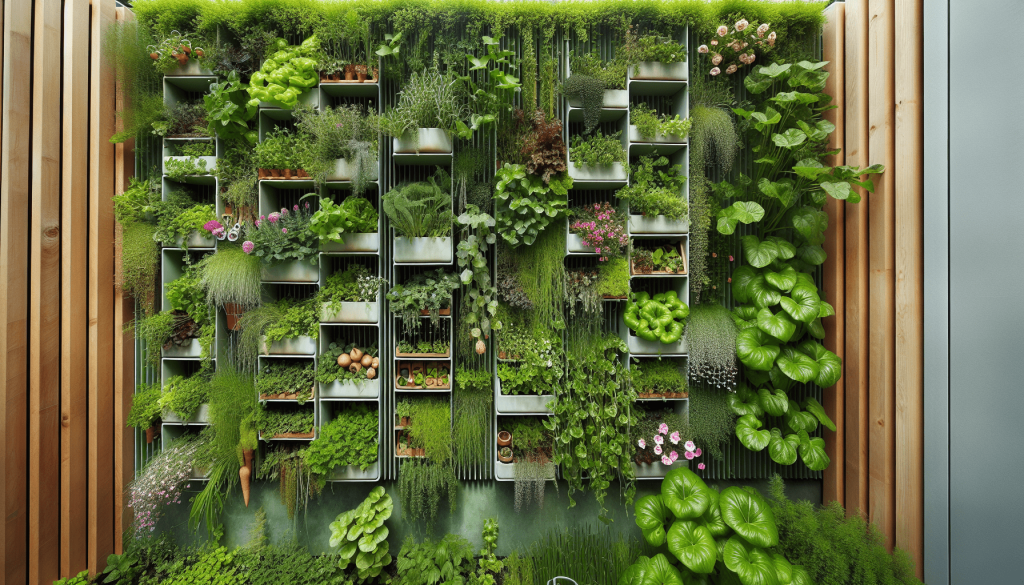This post may contain affiliate links. As an Amazon Associate, we may earn commissions from qualifying purchases.
Looking to maximize your garden space and add a touch of creativity to your outdoor sanctuary? “What Are The Best Ways To Incorporate Vertical Gardening Into My Garden Space?” is your ultimate guide to transforming your garden through innovative vertical gardening techniques. This article will walk you through practical and aesthetically pleasing ways to grow your greens vertically, making the most of your limited space while enhancing the overall appeal of your garden. Say goodbye to crowded plots and hello to lush, multi-dimensional landscapes!
What Are The Best Ways To Incorporate Vertical Gardening Into My Garden Space?
Have you ever wondered how you can make the most of your garden space? If you’re dealing with limited ground area but still want to enjoy the beauty of a lush garden, vertical gardening might be just what you need. But how do you start? What are the best ways to incorporate vertical gardening into your garden space? Let’s dive in and explore some efficient and creative solutions.
Understanding Vertical Gardening
Vertical gardening is an innovative approach that allows you to grow plants upwards rather than outwards. It involves using structures, containers, and systems that enable plants to grow vertically on a wall, fence, or other vertical space. This method not only maximizes your gardening space but also adds an eye-catching dimension to your garden.
Benefits of Vertical Gardening
First, let’s cover why vertical gardening is such a great idea. Here are some advantages:
- Space Efficiency: You can grow more plants in less space.
- Aesthetic Appeal: Vertical gardens add beauty and dimension to your space.
- Improved Air Circulation: Better air flows around plants, reducing diseases.
- Ease of Maintenance: Easier to water, prune, and harvest since plants are at eye level or higher.
- Better Yield: Often leads to healthier plants and higher productivity.
Choosing the Right Plants
When incorporating vertical gardening into your space, plant selection is crucial. Not all plants are well-suited for vertical growth, so you’ll need to choose wisely.
Best Plants for Vertical Gardens
Some plants thrive in vertical gardens, while others struggle. Here’s a helpful table to guide your choices:
| Plant Type | Examples | Why They Work Well |
|---|---|---|
| Climbing Plants | Clematis, Ivy, Morning | Naturally climb on structures, ideal for trellises and arbors |
| Glory, Wisteria | ||
| Trailing Plants | Pothos, Spider Plants, | Cascading growth habits, perfect for hanging |
| String of Pearls | baskets or high shelves | |
| Vegetables | Peas, Beans, Tomatoes, | Need support but can grow vertically, improving air circulation and yield |
| Cucumbers | ||
| Herbs | Thyme, Rosemary, Mint | Compact and aromatic, work well in small vertical spaces or containers |
| Flowers | Petunias, Geraniums, | Colorful and vibrant, add visual appeal to any vertical garden |
| Begonias |
Factors to Consider
When choosing plants for your vertical garden, here are a few factors to keep in mind:
- Sunlight Requirements: Make sure plants receive adequate light.
- Watering Needs: Select plants with similar watering needs to simplify maintenance.
- Growth Habit: Opt for plants that naturally grow upwards or can be trained to do so.
- Climate: Consider your local climate and choose plants that thrive in your conditions.

Selecting Vertical Gardening Structures
The structure you choose for your vertical garden will determine how effectively you can grow and manage your plants. There are various options available to suit different types of plants and spaces.
Types of Vertical Gardening Structures
Here are some popular options:
-
Trellises
- Description: Freestanding or wall-mounted grids made of wood, metal, or plastic.
- Best For: Climbing plants like peas, beans, and cucumbers.
- Advantages: Supports weight, allows for easy access and maintenance.
-
Wall-Mounted Planters
- Description: Planters attached directly to a wall or fence.
- Best For: Herbs, flowers, and small vegetables.
- Advantages: Space-efficient, adds aesthetic value, can be arranged in creative patterns.
-
Hanging Baskets
- Description: Suspended baskets filled with soil and plants.
- Best For: Trailing plants like petunias or strawberries.
- Advantages: Saves ground space, easy to water and maintain.
-
Vertical Planters
- Description: Stacked or tiered planters designed for vertical growth.
- Best For: Herbs, vegetables, succulents.
- Advantages: Maximizes planting area, can be moved around easily.
-
Green Walls
- Description: Fully integrated systems with a framework to support plants.
- Best For: Aesthetic and environmental benefits, dense planting.
- Advantages: Insulates the wall, improves air quality, visually stunning.
Building Your Own Structure
If you’re feeling creative, you can build your own vertical gardening system. Use materials like recycled wood, metal grids, or even old pallets. Custom-made structures can be tailored to fit the exact dimensions and aesthetic of your garden.
Planting in a Vertical Garden
Once you’ve chosen your plants and structure, it’s time to start planting. Here are some essential tips for success:
Soil and Fertilization
Just like traditional gardening, the quality of soil in vertical gardens is crucial. Use high-quality potting soil mixed with compost for nutrients. Regularly fertilize your plants to ensure they receive the proper nutrients needed for growth.
Watering Techniques
Watering can be a bit tricky in vertical gardens since gravity affects water distribution. Drip irrigation systems work well because they deliver water directly to the roots. Alternatively, you can hand water, ensuring each plant gets the right amount of moisture.
Arrangement and Spacing
Proper plant arrangement and spacing are essential for a healthy vertical garden. You need to:
- Position Taller Plants at the Top: This prevents them from overshadowing smaller plants.
- Space Plants Appropriately: Ensure each plant has enough room for root and foliage development.
- Consider Sunlight: Place plants with similar light requirements together for optimal growth.

Maximizing Vertical Garden Potential
Having a vertical garden doesn’t just mean growing plants; it means optimizing every element to get the most out of your space.
Companion Planting
Companion planting is a method where certain plants are grown together for mutual benefits. Some plants repel pests, while others improve growth or flavor.
Example Companion Planting Pairs
| Primary Plant | Companion Plant | Benefit |
|---|---|---|
| Tomatoes | Basil | Improves flavor and repels pests |
| Cucumbers | Nasturtiums | Deters aphids and improves yield |
| Beans | Corn | Provides natural support and fixes nitrogen in soil |
| Lettuce | Radishes | Radishes help deter pests from lettuce |
| Spinach | Strawberries | Mulches ground for moisture retention |
Advanced Techniques
Here are a few advanced techniques to further enhance your vertical garden:
Vertical Hydroponics
Vertical hydroponic systems allow plants to grow without soil, using nutrient-rich water instead. They are ideal for maximizing space and boosting growth rates.
Aeroponics
Aeroponics involves misting plant roots with nutrient solutions, which can result in even faster growth than hydroponics. This method, while more technical, is highly efficient for vertical systems.
Maintenance Tips for Vertical Gardens
Keeping your vertical garden in tip-top shape requires regular maintenance. Here’s how to keep everything flourishing:
Pruning
Regularly prune your plants to promote healthy growth. Remove dead or yellowing leaves and trim back excessive growth to ensure air circulation and light penetration.
Pest Control
Pests can be a problem in any garden. Opt for natural pest control methods such as neem oil or insecticidal soap. Regularly inspect plants for signs of pests like aphids or spider mites.
Seasonal Care
Adjust your care routine with the seasons. In winter, protect your plants from frost, and in summer, ensure they receive sufficient water.
Common Challenges and Solutions
Like any gardening method, vertical gardening comes with its own set of challenges. Here’s how to address some common issues:
Uneven Watering
As mentioned, gravity can cause uneven watering. Use a drip irrigation system or water-retaining gels mixed in the soil to help maintain moisture levels.
Weight Management
Some plants or structures can become top-heavy. Ensure your framework can support the weight, and consider using lightweight growing mediums or smaller containers.
Limited Sunlight
If your vertical garden doesn’t receive enough sunlight, consider using grow lights to supplement natural light. Choose energy-efficient LED lights that provide the spectrum needed for plant growth.
Inspiration and Ideas
Need some inspiration for your vertical garden? Here are a few creative ideas to get your wheels turning:
Edible Walls
Create a wall of herbs and vegetables right outside your kitchen. Not only will it be convenient, but it’ll also be a beautiful display of greenery.
Succulent Frames
Make a living picture frame by planting succulents in a wall-mounted frame. This low-maintenance option is perfect for those who love unique decorative elements.
Flower Towers
Build a tower of cascading flowers using stacked planters. This will create a striking focal point in your garden.
Conclusion
Vertical gardening offers a versatile and space-efficient way to transform your garden. From choosing the right plants and structures to advanced techniques and maintenance tips, you now have the knowledge to start your own vertical garden successfully. So, what are you waiting for? Dive into the world of vertical gardening and see how it can elevate your garden space.
We hope this guide provides you with all the information and inspiration you need. Happy gardening!








